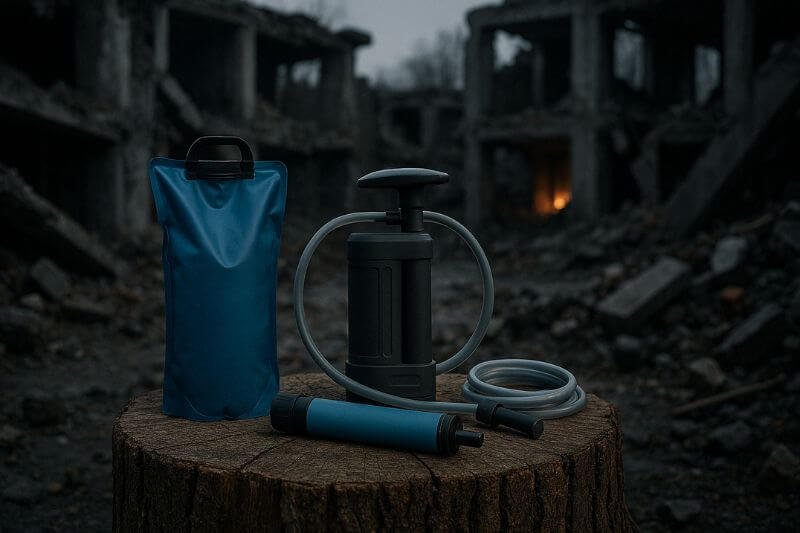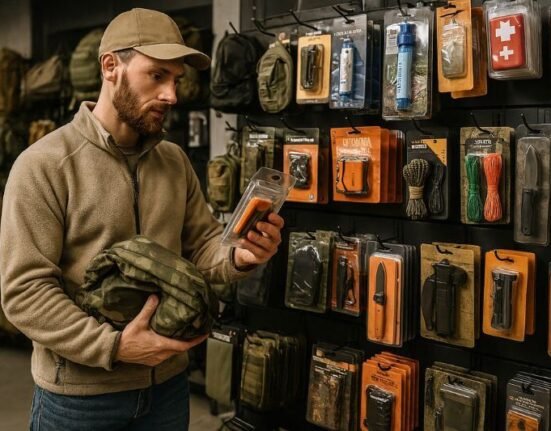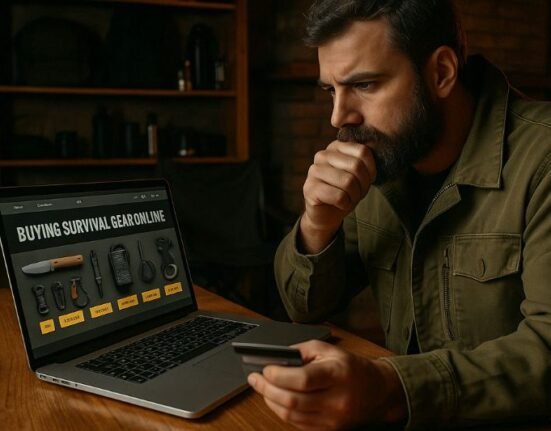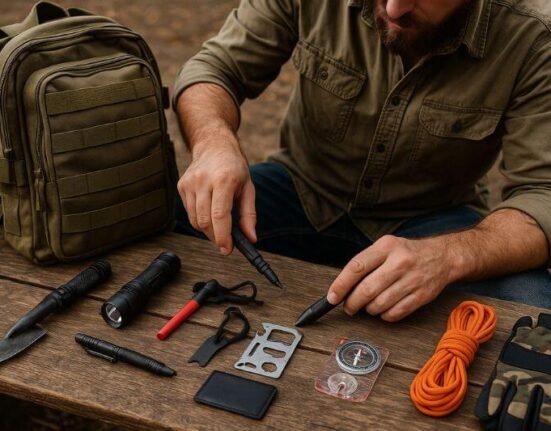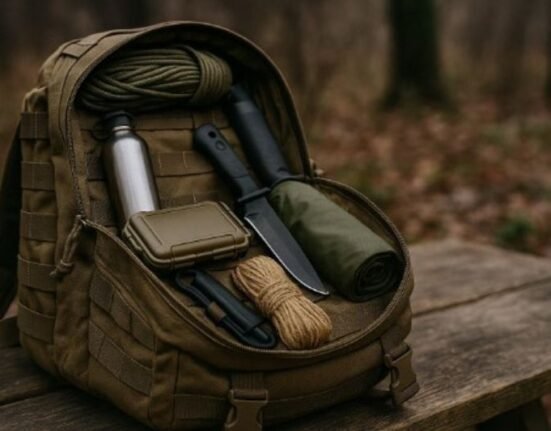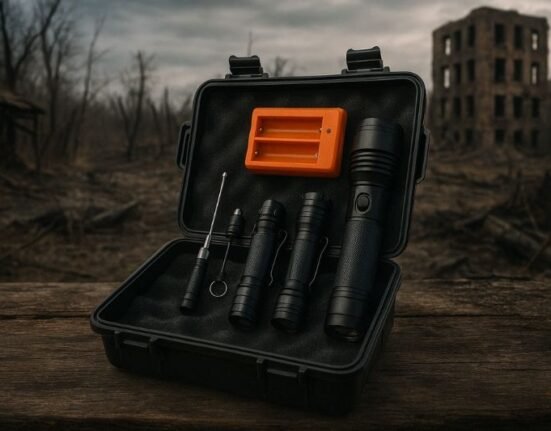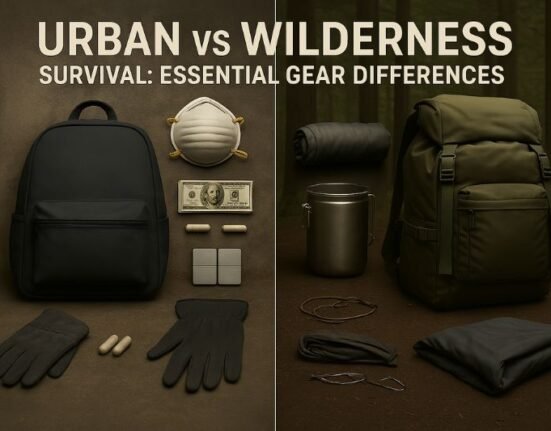In any survival scenario, water is life—but only if it’s safe to drink. Whether you’re bugging out through a flooded city, sheltering in place after an earthquake, or hiking deep into the wilderness to escape danger, the quality of your water supply can determine how long you last. That’s where survival water filters come into play.
While many preppers focus on food, tools, or defense, dehydration can become lethal in just 72 hours. Worse still, drinking contaminated water can lead to dysentery, cholera, E. coli, or other illnesses that incapacitate you quickly—precisely when you need strength the most.
But not all water filters are created equal. From gravity-fed filters perfect for basecamps, to ultra-lightweight straw filters ideal for bug-out bags, to manual pump systems with advanced purification capabilities, choosing the right model is more than a matter of taste—it’s a matter of strategy.
This guide compares the three most reliable types of survival water filters used by preppers, off-gridders, and outdoor survivalists. You’ll learn:
- How each filter works
- When to use them
- Their strengths, limitations, and maintenance needs
- Which one (or combination) fits your survival plan
In the chaos of a collapse or crisis, you won’t have time to guess. You need a water filtration system that’s tested, trusted, and tailored to your environment. This article will help you make that choice before the grid goes down—because once it does, it’s already too late to purify bad decisions.
Why Clean Water Is a Survival Priority
In a disaster, people often scramble for food, fuel, or shelter—but the first killer is dehydration. Without access to safe drinking water, your physical and mental capabilities degrade rapidly. And yet, it’s not just about having water—it’s about making sure it’s safe.
That’s why understanding and integrating survival water filters into your preparedness plan is not a luxury—it’s a necessity.
🧠 The Human Body and Water: Why It’s Urgent
The average person can survive:
- 3 weeks without food
- 3 days without water
- Just a few hours without shelter in extreme environments
But here’s what many forget: even mild dehydration—just 2% water loss—impairs your focus, slows your decision-making, and increases fatigue. In a high-stress scenario, that margin of error could be fatal.
Now imagine trying to escape a wildfire, bug out from civil unrest, or carry a child through mountainous terrain… without clean water.
☣️ What’s In Unsafe Water?
In survival settings, water is everywhere and nowhere. Lakes, streams, and puddles might look clean—but the risks are invisible.
Here’s what untreated water can carry:
| Contaminant | Effects |
|---|---|
| Bacteria (E. coli) | Vomiting, diarrhea, fever |
| Protozoa (Giardia, Cryptosporidium) | Prolonged intestinal illness |
| Viruses (Hep A, Norovirus) | Often missed by basic filters |
| Chemicals (pesticides, heavy metals) | Long-term organ damage |
| Sediment/Debris | Clogs gear, damages filters |
✅ In crisis conditions, one bad sip can weaken you when you need to be at full strength.
📦 Why Storing Water Isn’t Enough
Many preppers stockpile gallons of bottled water or fill bathtubs when warnings hit. While that’s useful short-term, it’s not sustainable. Here’s why:
- Stored water can become stagnant or contaminated
- Bottled water runs out—especially if you bug out
- In urban settings, your water source may be disrupted or poisoned
- Rain catchment and natural sources become essential
- Moving to secondary locations requires on-the-go purification
This is where survival water filters become essential—they turn unpredictable sources into reliable hydration.
🧭 The Survival Triangle: Fire, Shelter, Water
Every survivalist knows the rule of threes:
- 3 minutes without air
- 3 hours without shelter
- 3 days without water
- 3 weeks without food
Notice: Water is always #2 or #3 in any situation. It supports digestion, thermoregulation, detoxification, blood circulation, and joint mobility—all of which are critical when operating under stress or injury.
✅ The earlier you integrate water filtration into your gear and mindset, the more resilient you become.
🧪 Why You Need More Than Just Boiling
Boiling is effective—yes. But it’s not always feasible:
- It requires time and fuel
- It doesn’t remove sediment, metals, or chemicals
- You can’t boil water while on the move
- It reveals your position (smoke, light, smell)
Survival water filters fill in these gaps. They allow discreet, fast, on-demand purification without revealing your location or wasting energy.
💡 Real-World Example: Post-Hurricane Survival
After Hurricane Maria in Puerto Rico (2017), one of the biggest reported shortages wasn’t food—it was clean drinking water. Many survivors were forced to drink from contaminated wells or makeshift sources. Diarrhea, dysentery, and dehydration surged.
Those with compact water filters, especially straw types and gravity filters, were able to sustain themselves and even help neighbors.
Preparedness equals freedom. And in this case, it saved lives.
✅ Key Takeaway:
Clean water isn’t optional. In survival, it’s foundational. Without a reliable filtration system, you’re gambling your health on luck. And in a crisis—luck runs out fast.
Survival Water Filter Types Explained: Gravity, Straw, Pump
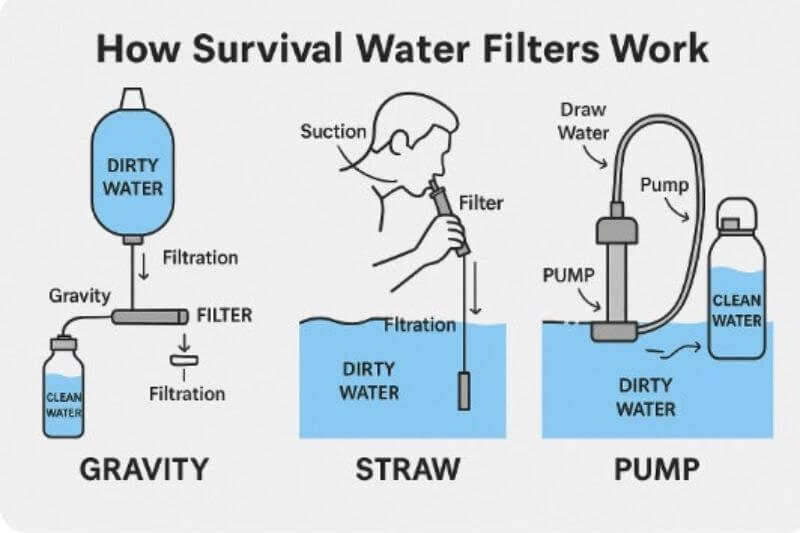
When it comes to water filtration in survival situations, not all filters serve the same purpose. The right tool depends on your environment, group size, mobility, and long-term strategy.
Let’s break down the three most reliable types of survival water filters—gravity, straw, and pump—so you understand how they work, when to use them, and what trade-offs to expect.
🪣 Gravity Filters – Best for Basecamps and Group Use
Gravity filters use a simple principle: elevation and time. You pour untreated water into an upper reservoir (like a soft bag or bucket), and gravity pulls it through a filter cartridge into a clean container below—no pumping required.
✅ Advantages:
- Filters large volumes with little effort
- Ideal for basecamps, group bug-outs, or off-grid homes
- Requires no physical exertion—good for the injured or elderly
- Often includes multi-stage filtration (bacteria, protozoa, sediment)
❌ Limitations:
- Slow flow rate (especially in cold weather)
- Not ideal for movement or quick hydration
- Bulky when packed
- Needs height clearance to hang
💡 Best Use Case:
- Setting up a camp during a multi-day bug-out
- Purifying water for a family or small group
- Filling multiple bottles before departure
Examples:
- Sawyer Gravity System
- Platypus GravityWorks
- Berkey (for stationary use)
🧴 Straw Filters – Ultralight and Instant, But Limited
Straw filters are compact tools you drink through directly—like a straw—pulling water through a filter as you suck.
✅ Advantages:
- Extremely lightweight and compact (fits in your pocket)
- No setup or power source needed
- Affordable and disposable
- Great as a backup or EDC tool
❌ Limitations:
- Single-user only
- No way to store water—only drink directly
- Not ideal for group use or long-term filtration
- Most don’t filter out viruses or chemicals
💡 Best Use Case:
- Emergency escape routes
- Minimalist bug-out bags
- Backup tool inside a medkit or jacket pocket
Examples:
- LifeStraw Personal
- Sawyer Mini
- HydroBlu Sidekick
✅ Pro Tip: Pair a straw filter with a collapsible bottle or bladder so you can scoop water and drink later—not just at the source.
💪 Pump Filters – High Control and Tactical Flexibility
Pump filters use manual pressure to push water through a fine filter, often with ceramic or carbon layers. You dip the intake hose into a source and pump the handle to move water into your bottle.
✅ Advantages:
- Precise and controlled filtration
- Many models filter viruses, bacteria, protozoa, and chemicals
- Can filter from shallow sources (puddles, cracks, urban runoff)
- Some models allow pre-filtering of sediment
❌ Limitations:
- Requires manual effort
- More moving parts = more maintenance
- Typically heavier and bulkier than other types
- Slower than gravity filters for group use
💡 Best Use Case:
- Solo or duo travel with unpredictable water sources
- High-risk zones (urban collapse, sewage runoff)
- Long-term off-grid setups with mixed contamination levels
Examples:
- MSR Guardian
- Katadyn Hiker Pro
- Survivor Filter Pro
✅ Maintenance Note: Always flush or dry your pump after each use to prevent bacterial growth inside the cartridge.
🔄 Summary Table: How They Compare
| Filter Type | Weight | Speed | Ideal For | Limitations |
|---|---|---|---|---|
| Gravity | Medium | Slow | Groups, basecamp | Needs setup, bulkier |
| Straw | Very low | Instant | Solo, minimalist EDC | No storage, direct use only |
| Pump | High | Medium | Tactical, solo or duo | Manual effort, upkeep |
✅ Key Insight:
The best survivalists don’t rely on just one. They build redundancy: a pump or gravity filter for base use, and a straw or mini-filter for mobility. Every filter type has a role—know when to deploy it.
Which Filter Should You Choose? Pros, Cons, and Use Cases
You now understand the mechanics. But which survival water filter is right for you? That depends on your plan, your terrain, your health, and your level of preparedness.
This section will help you decide based on realistic, survival-driven criteria—not marketing claims or gear hype.
📊 Gravity vs. Straw vs. Pump: Side-by-Side Comparison
| Feature | Gravity Filter | Straw Filter | Pump Filter |
|---|---|---|---|
| Water Volume | High (5–10L+) | Low (sips only) | Medium (1–2L per session) |
| Best For | Groups, basecamps | EDC, bug-out backup | Tactical movement, solo use |
| Flow Speed | Slow | Instant (direct only) | Medium (manual control) |
| Filtration Quality | High (varies by brand) | Medium (bacteria only) | High (bacteria + viruses*) |
| Weight/Bulk | Medium-high | Very low | Medium |
| Maintenance | Low | None | Moderate (cleaning, flushing) |
| Cost | $$ | $ | $$$ |
| Shelf Life | Long | Single-use or short | Medium to long |
*Some pump models can remove viruses with integrated carbon or membrane filters.
🧭 Urban vs. Rural Survival Contexts
Your environment dramatically affects what water filter you need.
🏙️ Urban Collapse:
- Water sources: gutters, burst pipes, contaminated reservoirs
- Risks: chemicals, heavy metals, sewage, viruses
- Best filters: pump filters with chemical/virus stages
- Backup: straw filter for mobility and stealth
🌲 Rural/Forest Bug-Out:
- Water sources: rivers, streams, lakes, snow
- Risks: bacteria, protozoa, sediment
- Best filters: gravity filters for camp + straw for quick sipping
- Bonus: can integrate with solar setups or long hikes
🚶 Mobility-Focused (on foot):
- Priorities: weight, speed, stealth
- Best filters: straw filter or mini-pump
- Tip: Use a gravity bladder at night + straw by day
✅ Hybrid setups often win: combine a straw filter (for active use) with a gravity or pump model (for resupply and camp).
🔁 Redundancy: The Smart Survivalist’s Rule
A single point of failure = disaster. That’s why every seasoned prepper follows this principle:
“Two is one, one is none.”
Recommended filter kit:
- 🎒 Primary: Pump or gravity filter (main use)
- 🧥 Secondary: Straw filter in jacket or EDC kit
- 🧳 Backup: Chemical tablets or boiling as fallback
Bonus: keep spare cartridges or hollow-fiber membranes. Some models fail due to freezing, clogs, or bacterial buildup.
🧪 Long-Term Survivability and Maintenance
After 1–2 weeks off-grid, your water filter must still perform.
- Gravity filters need backflushing every 10–20 liters
- Straw filters should be replaced every 1000 liters or so
- Pump filters require field maintenance kits
- Filters exposed to freezing temperatures while wet may crack internally—rendering them useless
✅ Store filters in insulated pouches during cold nights.
✅ Keep a laminated maintenance card in your bug-out bag.
🧠 Real-World Scenario Planning
| Scenario | Recommended Filter Setup |
|---|---|
| Wildfire evacuation (vehicle + shelter) | Gravity filter + straw backup |
| Urban collapse / rioting | Pump filter with carbon stage + EDC straw |
| Solo hiker lost in wilderness | Straw filter primary + iodine tablet backup |
| Long-term homestead with family | Gravity filter + manual pump + rain catchment system |
| Flood disaster (polluted water) | Pump filter (chemical + virus filtering) + boil backup |
✅ Consider who you’re prepping for: Are you alone, with kids, elderly, pets? Each situation shifts the filtration demand.
🔚 Final Word: Don’t Gamble with Your Hydration
In survival, water is non-negotiable. The right survival water filter gives you control over one of the few resources you can’t live without. It turns chaos into strategy. And more than anything, it lets you move, act, and survive—confidently.
You don’t rise to the level of your gear.
You fall to the level of your worst-prepared day.
So pack smart. Filter smarter.
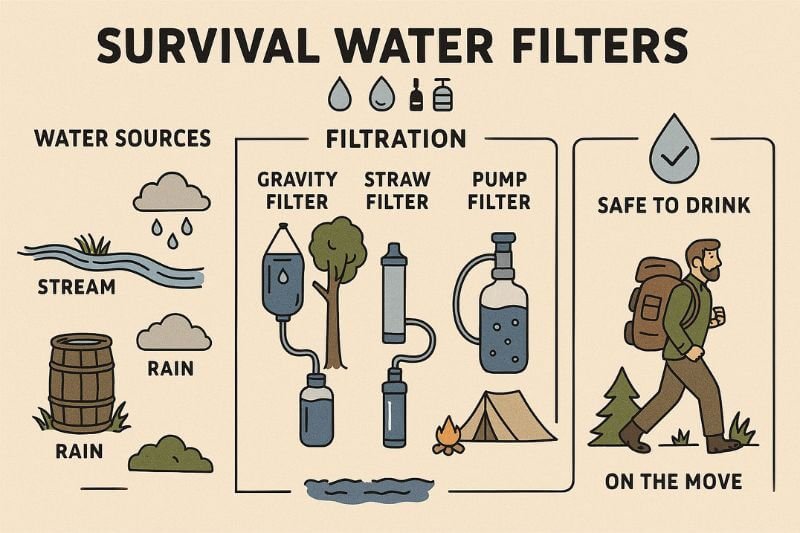
❓ Frequently Asked Questions (FAQ)
💧 What’s the shelf life of most survival water filters, and do they expire?
Yes—all survival water filters have a lifespan, even if unused. Most filters rely on hollow fiber membranes, carbon elements, or ceramic cartridges, all of which degrade over time or become ineffective after a certain volume of water.
Typical shelf life by type:
- Straw filters (e.g. LifeStraw): 3–5 years sealed, ~1000 liters use
- Pump filters: 5–10 years sealed, 1000–2000+ liters
- Gravity filters: 5+ years if dry; backflush regularly after use
What causes early expiration?
- Freezing while wet (can crack membranes)
- Mold/bacteria growth from improper drying
- Clogging by muddy water or silt
- Carbon filter saturation (no more chemical/odor removal)
✅ Store filters in a cool, dry, and dark location, and rotate stock like you would with food. Always label the “opened” date and test annually.
🌊 Can survival water filters be used with saltwater?
No—most survival water filters cannot desalinate. They’re designed to remove biological contaminants (bacteria, protozoa, viruses) and sediment, not salt molecules.
Saltwater requires:
- Desalination systems (reverse osmosis or distillation)
- Evaporation stills or solar distillers in field setups
- Boiling and condensation traps for improvised collection
Trying to drink seawater through a standard filter (pump, straw, gravity) won’t work—and it may still lead to dehydration, kidney damage, and worsening thirst.
✅ If you live near the ocean, research emergency desal kits or build a DIY solar still as part of your water strategy.
🔁 How often should I clean, backflush, or replace a survival water filter?
Maintenance = longevity. Here’s how to care for each type:
Gravity filters:
- Backflush after every use if used with dirty water
- Replace filter element every 1500–3000 liters (check brand)
- Rinse and fully dry before long-term storage
Pump filters:
- Clean pre-filters and hoses weekly during use
- Backflush ceramic/carbon elements as instructed
- Lubricate moving parts with food-grade silicone
- Replace internal cartridge every 1000–2000 liters
Straw filters:
- Blow out excess water after each use
- Store in a breathable case (not sealed plastic)
- Discard if flow becomes weak or taste changes noticeably
✅ Always carry a syringe or backflush tool with your gear—it weighs almost nothing and can revive a clogged filter in seconds.
🔥 Are survival water filters better than boiling water?
It depends on the situation. Both methods have pros and cons, and neither is a complete solution alone.
| Method | Pros | Cons |
|---|---|---|
| Boiling | Kills all pathogens (even viruses) | Doesn’t remove chemicals or sediment |
| Simple, no gear needed (just heat) | Consumes fuel and time | |
| Reliable in most regions | Not mobile or stealthy | |
| Filtering | Removes bacteria, protozoa, sediments | Some don’t remove viruses |
| Portable and on-demand use | May clog or degrade without care | |
| Doesn’t require heat or reveal location | May miss chemical contaminants |
✅ The best survival strategy? Use both:
- Filter first → then boil for virus protection (especially in urban or developing areas)
- Filter when mobile → boil when settled at camp
Filtration is about speed and stealth. Boiling is about certainty.









